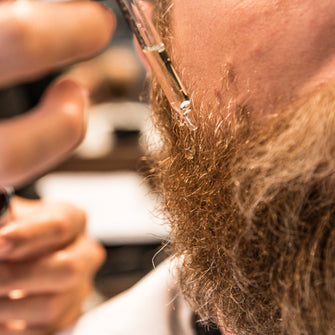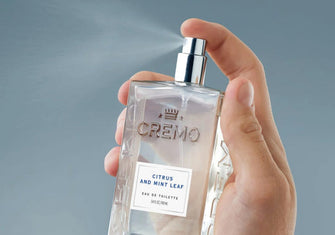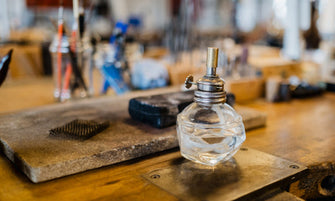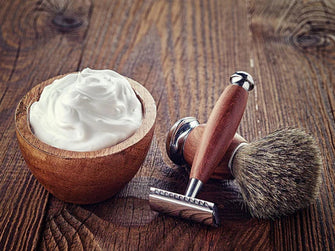June 21, 2022
How to Grow A Beard Faster and Naturally
While growing a beard may seem as easy as putting down the razor, there is a lot more to it. Beards require patience, maintenance, and self-confidence to get past those awkward stages. The good news is with the right strategy; an amazing beard is in your grasp. However, the process will not be the same for everyone, nor will the beard. It’s important to manage expectations and rock the facial hair you have. After all, beards are completely personal. Some guys like big beards, some like simple stubble.
This guide touches on the pro tips for growing a successful beard and what to expect as your hair grows out. It also goes into the science of beard growth and how to improve the rate your beard grows.
Table of Contents
- How To Grow A Beard - Pro Tips
- What To Expect When Growing A Beard
- Stages of Beard Growth
- Understanding The Science Of Beard Growth
- Factors of Beard Growth
- Beard Hair Growth Cycle
- 6 Ways To Improve Beard Growth
- FAQs for Growing A Beard
- TLDR
How To Grow A Beard: Pro Tips
Make The Commitment
The key elements in growing a beard are patience and the will not to give up. You need to remember your goal and not immediately shave your beard when things get tough. The first few weeks can be difficult between the itchiness and discomfort of hairs poking through your skin. You will be tempted to scratch, rub, and shave the mess. Hang in there.
Let It Grow
Most beginner beardsman make the mistake of giving up too early. It takes time to get a full beard. Not all hairs grow at the same rate or to the same length. If you only let your beard grow out for a few weeks and give up you won’t get to see the full potential your beard could be. If you are serious about growing a beard, you have to give it more than 30 days of growth before deciding to shave or trim.
Although variable growth rates can leave your beard looking uneven and patchy, resist shaping or trimming it for the first 4-6 weeks. Waiting allows your beard to fill out and better your understanding of your hair type and growth pattern. If you grab your beard shears and trimmers at every sight of a flyaway or patchy area, you will never reach your goals. Trust us; you can’t trim your way to a longer beard.
Keep your hands off your face and let your beard do its thing. The more you touch or agitate your facial skin and hairs, the more damage and stress you put on your follicles. Not to mention your hands are covered in oils and bacteria that worsen the quality of your beard growth. Just let it grow.
Don’t Wait To Start Using Beard Products
Like it or not; a beard requires maintenance. The sooner you start using beard products and establish a beard care routine, the better.
Beard oil works wonders for hydrating and nourishing your facial skin and hairs to help hairs come in healthy and soft. It can also help eliminate the beginner beard woes such as itchiness and flakiness.
For most men, washing their face is tied to their shaving routine. Even though you are no longer shaving, your face needs to be cleaned to facilitate hair growth and keep your skin moisturized and healthy. Beard & Face Wash is also essential to start using immediately to eliminate the grime that can build up and clog pores.
As your beard grows, you will want to introduce a beard brush to direct hairs, increase circulation and exfoliate your skin. Once your beard passes short length, you will want to start using a beard comb to detangle and distribute natural oils and products.

Have Realistic Expectations
When you first grow a beard, you need to pay attention to how and where it grows. Knowing your potential as a beardsman and your genetic limits are essential for the success of your beard.
Expect to have some messiness at first. A month-long beard will be a little patchy, a little wild. Don’t judge your beard by these first few weeks. Growing a beard is about experimenting. It will take trial and error to figure out what works best for you and your beard.
We will repeat it. Do not touch your beard for the first 4-6 weeks. Leave it alone. After just a few days of growth, it is hard to see the natural shape of your beard. Giving your facial hair longer to grow in will make trimming and styling easier in a few weeks.
Plan Your Beard Lines and Set Your Goals
Before growing a beard, educating yourself on what kind of beard will look best on your face shape is important. Understanding how your facial hair fills in and its growth patterns are also things to consider when choosing your beard style. Do your chin and mustache areas fill in full and thick but not your cheeks? A goatee might be the perfect beard for you.
Find a style that is unique to yourself and reflects your personality while embracing your best features and complimenting your face shape and natural beard shape. Read up on some of our favorite beard styles for some inspiration.

Trim Your Beard Into Shape
The big difference between an intentional, well-maintained beard and an untouched caveman beard is trimming and shaping. After the 4-6 week mark, you have a good idea of what your beard can do and are ready to start cleaning it up. There is no shame in the barber game, especially for your first shape-up or trying a new beard style. Find a trusted barber who is going to take care of you.
If you do want to trim and shape up your beard at home, follow these quick guidelines:
- Cheeklines: Don’t want to trim your cheek line any lower than the corners of your lips
- Neckline: To find your neckline, make an L shape with your thumb and pointer finger. Place your pointer finger at your sideburns. Anything below your thumb you shave, anything above you keep.
- Backline: Bring your sideburns down to meet your neckline
- Focus on not trimming your neckline too high or your cheeklines too low. That is not flattering.
- Always trim less than you think. You can always come back and trim a little more off.
- Don’t destroy your beard trying to make it perfect. If it is a bit uneven, leave it alone. We promise no one will be looking at you.
For a full refresher, read how to shape and trim your beard.
Don’t Compare Your Beard To Others
One of the biggest misconceptions men have is the only beard worth growing is the full-length, full-grown beard. The truth is beards come in all different styles and varieties. Everyone has different amounts of facial hair, growth patterns, and texture. Don’t be afraid to rock some facial hair, even if it isn’t thick and full. All beardsman go through patchy, awkward, and unkept stages, so don’t worry if your beard doesn’t automatically look the way you want. We all struggle with different quirks about our beards we don’t love.
Finding quality products and beard styles highlighting your best features will make your beard journey more manageable. It’s best to focus on what your beard can do instead of what it can’t. You won’t be successful if you try to grow someone else's beard; just grow your own beard. You can get inspiration but don’t compare your beard, especially your beginning beard, to your beard icons.
What To Expect When Growing A Beard

How Long Does It Take To Grow A Beard?
Typically, growing a full beard can take anywhere between 2 to 6 months. However, every beardsman’s hair will grow at different rates due to age, genetics, hormone levels, and other factors, so there is no straight answer to how long it could take a person to grow a beard.
The average daily growth of beard rate ranges between 0.3 and 0.5 mm, which adds up to around half an inch per month. So if you do the math, the average man could have a beard of up to six inches in length after a year of growth with minimal trimming.
Stages of Beard Growth
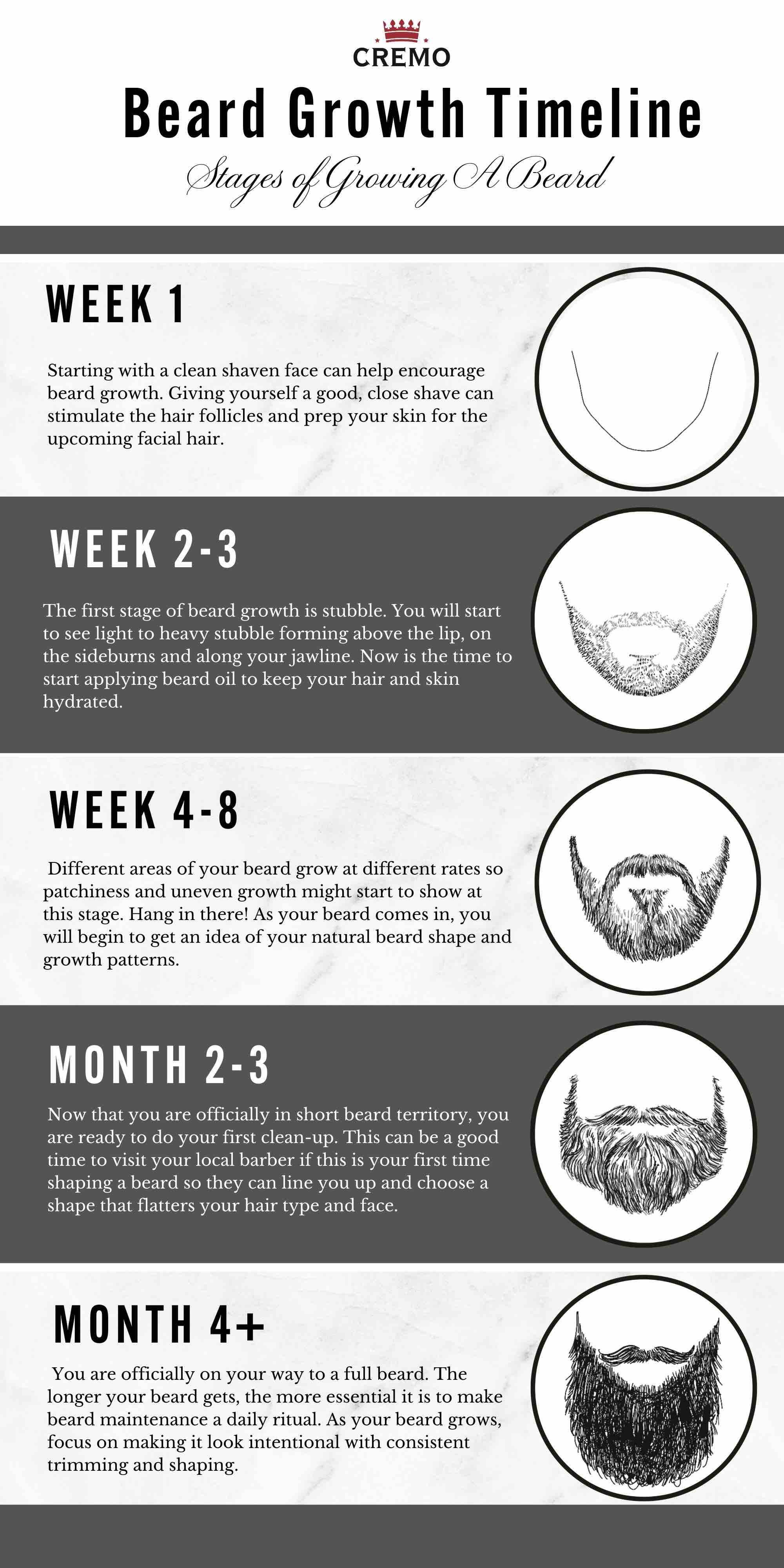
Stage 1: Clean Shaven (Week 1)
Starting with a clean-shaven face can help encourage beard growth. How does shaving help beard growth? Giving yourself a good close shave can stimulate the hair follicles and prep your skin for the upcoming facial hair. It's best to shave right out of the shower once your pores are opened, and your follicles are soft for a cleaner cut. Massage your shaving cream into the skin with circular motions and grab your razor. Always Shave with small strokes going with the grain. If you need a shaving refresher, check out our guide on shaving tips for men.
Stage 2: Stubble (Week 2-3)
The first stage of beard growth is stubble. You will start to see light to heavy stubble forming above the lip, on the sideburns, and along your jawline. This growth will be your first indication of the areas you will have consistent hairs and the spots that might be patchy.
Now is the time to start applying beard oil to keep your skin and facial hair moisturized to stay on top of beardruff and the dreaded beard itch. Some men prefer to keep their beards at this 5 o’clock shadow length.
Stage 3: The Awkward Stage (Week 4-8)
If it is longer than an inch, it's no longer stubble. During this stage, you will have noticeable growth and potentially a little messiness. Different areas of your beard grow at different rates, so patchiness and uneven growth might start to show. Hang in there! As your beard comes in, you will begin to get an idea of your natural beard shape and growth patterns. The chin, mustache, and jawline have the most substantial growth for most men.
Start thinking about what beard style you want, but avoid the temptation to trim your beard or even out any lengths at this stage. You will likely take too much off and have to start over. Just let your hair continue to grow and fill in, making trimming and shaping easier later on.
Stage 4: Time to Start Shaping (2-3 Months)
Now that you are officially in short beard territory, you are ready to do your first clean-up. At this point, you can get a complete idea of your beard's strengths and natural shape. If this is your first time shaping a beard, You might want to visit your local barber so they can line you up and choose a shape that flatters your hair type and face.
If you trim at home, start with your neckline to prevent the neck beard. Depending on your chosen style, you might want to even out some length or clean up your cheeklines and backlines. Read our full guide on how to shape and trim your beard for a step-by-step tutorial.
Stage 5: Medium beard and beyond (4 Months +)
You are officially on your way to a full beard. Give yourself some praise for making it through the tough beginning stages.
The longer your beard gets, the more essential it is to make beard maintenance a daily ritual. Washing and conditioning regularly and applying beard balm and beard oil will keep your beard soft and manageable. Keeping up with combing and brushing your beard will eliminate knotting and smooth and train your hairs to lay the way you want. You might notice beard growth slowing at this point.
As your beard grows, focus on making it look intentional with consistent trimming and shaping. Once you have enough length, you can start styling your beard with heat or products like beard balm to give it extra character and definition. Read more about beard balm in our post, Beard Balm: What is it and do I really need it?
Understanding the Science of Growing A Beard
What Stimulates Beard Hair Growth?
An enzyme in your body called 5-alpha reductase converts your stored testosterone into another hormone called dihydrotestosterone (DHT). This extra potent form of Testosterone, DHT, then attaches to receptors on each follicle of your beard hair to stimulate growth.
The Beard Hair Growth Cycle
Your hairs are growing and renewing themselves constantly. All hairs - including beard hairs - go through these 4 phases:
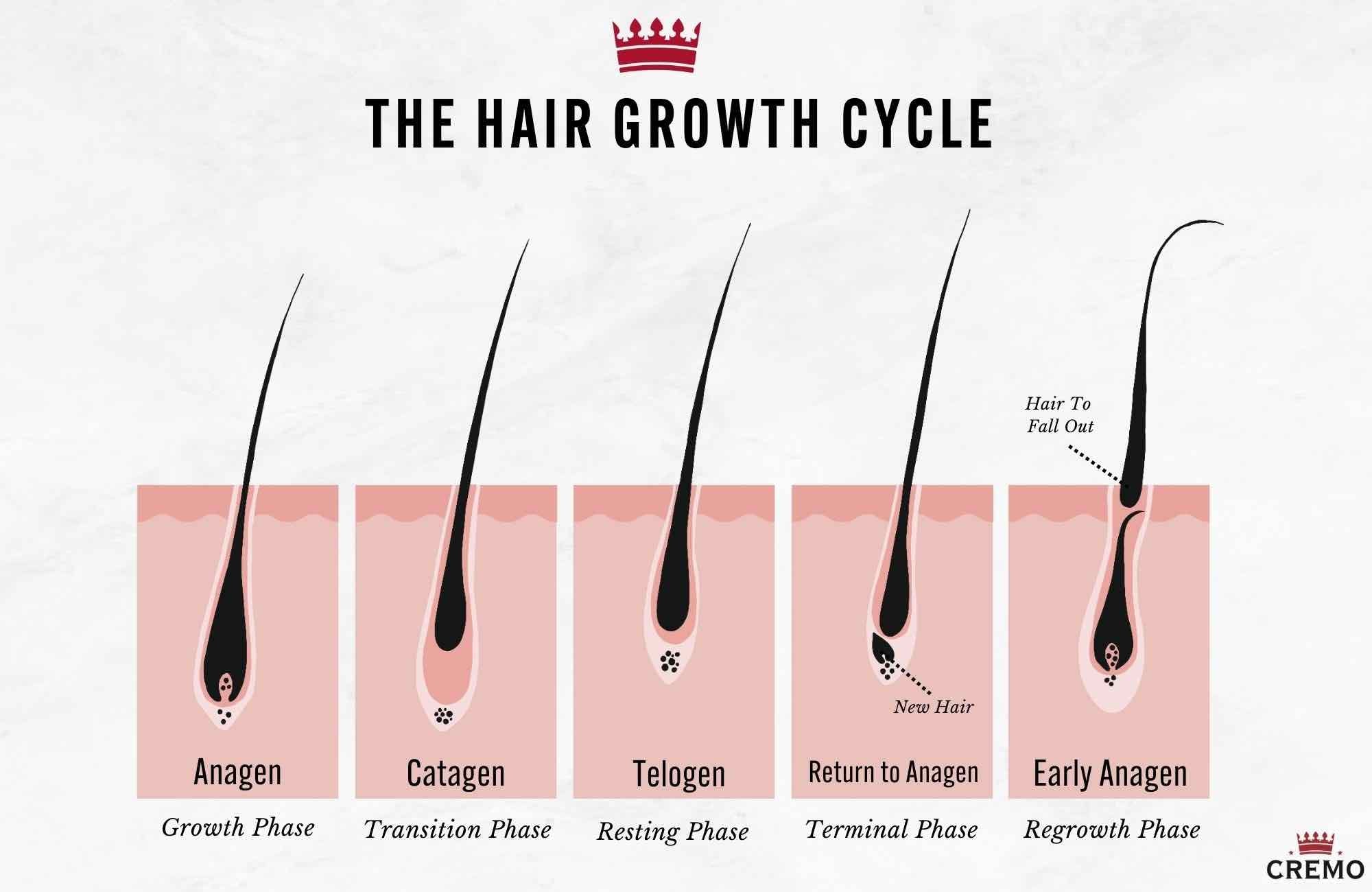
- Anagen Phase (Active Growth Phase) - Hair grows about half an inch per month and continues to grow for about 3 to 4 years, even if cut.
- Catagen Phase (Transition Phase) - The shortest cycle that lasts about three weeks. The hair follicle shrivels away from the follicle and attaches to the skin cutting off nutrients and blood.
- Telogen Phase (Resting Phase) - The follicle stays dormant for a few months, then pushes out the old hair and begins growing a new hair. This process is known as shedding.
- Terminal Length (Return to Anagen) - The end of the hair's life cycle when it ceases to produce length and the stage at which old hairs are replaced by new growth. The average terminal length ranges from 12 inches to 36 inches.
It's important to note that not all hairs on your face do not have the same terminal length. The patterns and growth rate vary for each area on your face, so beards rarely grow even and uniform. For example, mustache hairs typically don’t grow as long as those on your chin or cheeks.
There are five main regions on your face where beard hair grows:
The Mustache - Hair above the upper lip
The Soul Patch - Area of hair directly under the bottom lip
The Goatee - Hair on the front of the chin, above the jawline, expanding onto the cheeks
The Side-Burns - Hair on the cheeks above the jawline
The Neck - Everything that grows below the jawline; creates the bulk of the beard

Paying attention to how your hairs fill in and when different areas in your beard reach terminal length will help you choose a realistic beard style that works with your facial hair.
Does Your Beard Ever Stop Growing?
The short answer - is no. Your beard will continuously produce hairs, but beards do reach a stage where they stop growing length. Each isolated hair has a unique set length; the strand will fall out and be replaced by a new one. Hair follicles reset as the old hair sheds, and new hair starts growing from the same follicle again. This process is referred to as “terminal beard.”
So a better question to ask might be - how long can an individual's beard hair grow?
According to the Guinness World Records, the world record beard was held by Hans Nilson Langseth and reached 17 feet 6 Inches. While this might be extreme, most men average about 12 inches of growth.
Factors of Beard Growth
Genetics
Your baseline beard growth rate and beard growing potential are rooted in your genetics. Some men can have a full beard within two months by doing absolutely nothing, while others can wait the same amount of time just to see a few hairs pop up on their faces. To understand how genes might affect your hair growth, look at the other men in your family. Do they have a history of hair loss? Patchy facial hair? Full beards? Most likely, you will also have whatever growth patterns your family has.
Genetic variations can affect the number of androgen receptors on your face and your follicles' sensitivity to DHT, an essential hormone in growing a full beard. These variations result in some men with high sensitivity having full bushy beards and others with low sensitivity having thin, sparse beards.
But don’t despair yet. There is still hope for your beard with a bit of patience, a proper care routine, and realistic expectations, whether you have good genes or bad genes. While genetics are important, they aren’t everything.
Age
When it comes to growing a beard, age does matter. While the first phase of hair growth in males usually occurs between 12-16 years of age, the prime for growing a beard is typically between 25 and 35. This window is when testosterone levels are rising, and the growth phase (anagen) is the longest. Typically, the growth rate is highest at these ages.
After that prime timeframe, Testosterone levels typically start declining. As men age, testosterone levels drop gradually, about 1 - 2% per year. The Urology Care Foundation found that 4 in every 10 men over 45 have low Testosterone levels. White hairs have the possibility to grow twice as fast as pigmented hair, so some men may experience a spike in hair growth as their beard starts to grey.
But this data is not black and white like most things to do with beards. Many men experience successful beards at all ages. Just because you weren’t successful when you first tried to grow a beard in your early twenties does not mean you can’t grow a full, healthy beard in your 30s. As they say, you won’t know until you try.
Hormone Levels
Testosterone and Dihydrotestosterone (DHT) are both culprits for regulating and stimulating facial hair growth. In most cases, higher Testosterone and DHT result in faster, thicker, and better beard growth. Having low levels of Testosterone can negatively affect your beard growth.
Clinically low testosterone levels may call for a doctor, but most men can increase these levels naturally with a healthy lifestyle. While growing a great beard isn't as simple as just increasing these hormones, we will discuss specific ways to naturally increase these levels and boost beard growth in the next section.
6 Ways To Improve Beard Growth
Your overall health affects everything, including your beard. The healthier you are, the healthier your beard will be. While you can’t alter your genetics or age you can make a few lifestyle choices to encourage beard growth.

Eat Right
Focusing on a well-balanced diet will fuel your body and help you sprout stronger, thicker hair. There is a strong relationship between a proper diet and testosterone levels.
What Your Body Needs To Grow A Healthy Beard:
- Protein- hair is made of protein, so protein-rich foods will help your hair grow stronger and healthier. Make sure you have plenty of lean proteins like meat, fish, eggs, and nuts in your diet.
- Omega-3 Fatty Acids - Hair is also made of fat, so including sources of healthy fats like salmon and sardines will keep your hair hydrated and shiny.
- Vitamin A- helps regenerate cells and stimulate hair growth. Sweet Potatoes are a great source of this.
- Biotin- Biotin boosts your body’s keratin infrastructure keeping your hair strong and preventing breakage. A Biotin deficiency can lead to thinning hair or skin irritations. Eggs are excellent sources of this!
- Iron - As an essential vitamin in your diet, deficiencies can stunt hair growth and cause hair loss. Iron produces hemoglobin which supplies oxygen to the cells around your hair to encourage growth. Without iron, your hair is not growing anywhere. Spinach is an excellent source of iron and is a versatile food that is easy to add to your diet to help your beard grow faster and fuller.
- Vitamin D- This vitamin is essential in the production of Testosterone. Vitamin D also helps reactivate the hair follicles in your face that have stopped producing hair.
- Zinc - Zinc plays a significant role in strengthening your follicles and keeping your skin, scalp, and nails strong and healthy.

| Nutrient | Benefit to Hair | Sources |
|---|---|---|
| Protein | Helps hair grow stronger and healthier | Lean meats like fish, eggs, nuts |
| Omega-3 Fatty Acid | Keep hair hydrated and shiny | Healthy fats like salmon and sardines |
| Vitamin A | Regenerates cells and stimulates hair growth | Sweet Potatoes, kale, spinach, broccoli, milk, eggs |
| Biotin | Boosts your body’s keratin levels keeping hair strong and prevents breakage | Eggs, seeds, nuts, meat |
| Iron | Supplies oxygen to cells around your hair encouraging growth | Dark leafy vegetables like spinach, red meat, beans, peas |
| Vitamin D | Reactivates hair follicles that stopped producing hair and essential for the production of Testosterone | Fatty fish like sardines, salmon, tuna, and fish liver oil |
| Zinc | Strengthens follicles and keeps your skin, scalp and nails strong and healthy | Whole grains, milk, oysters, red meat and poultry |

Excercise
Overall, exercise helps make your body healthier, encouraging healthy hair growth. Regular exercise three to four times a week has been associated with stable testosterone levels, which promotes healthy hair growth. Harvard Medical School has also linked excess body fat and obesity to lower testosterone levels furthering the importance of staying fit. Between 10 - 20% of body fat is ideal for healthy testosterone production. Lowering your body fat with a healthy diet and regular exercise can raise your testosterone levels.
Benefits of Exercising:
- Improved Circulation: Exercising increases your heart rate, which increases blood flow and the productivity of hair follicles. Blood carries oxygen and essential nutrients throughout your body, so increased circulation means your skin and hair follicles receive more fuel to build healthy, strong strands.
- Testosterone Boost: With sufficient exercise, your body will likely begin to produce elevated testosterone levels, spurring faster, healthier hair growth. Lifting weights or other strength-training activities and HIIT or High-Intensity Interval Training both significantly impact testosterone levels as they utilize many muscle groups.
- Metabolism Increase: Exercise can help jumpstart your metabolism, helping you grow a fuller beard. The high volume and metabolic demand of resistance training have been proven to create an acute increase in testosterone levels.
Get Enough Sleep
Lack of sleep is a common suppressor of hair growth. Not getting enough sleep can adversely affect this process and disturb the hormonal production of Testosterone and DHT. In an NIH Study, “Sleep deprivation decreases the beard-hair growth in man,” when a group of men was deprived of sleep for 48 hours, they showed decreased levels of beard growth by 19 percent.
Sleep is essential for overall health and can be beneficial for beard growth. Since your body produces most of your testosterone at night when your brain is asleep, getting 7-8 hours of sleep per night will allow your body to produce the beard-building hormones you need. Studies show a healthy sleep cycle can increase the rate and consistency of hair growth.
Manage Stress Levels
Managing the stress in your life should be a priority. High cortisol levels (a chemical released when stressed) slow the body’s testosterone production and constrict blood vessels causing hairs to receive fewer nutrients and vitamins needed to grow.
Stress upsets the growth cycle of your facial hairs and forces follicles to go into the resting phase, halting the production of new strands. Overall, unmanaged stress can lead to hair loss and stunted hair growth.
Ways to reduce and manage stress:
- Reduce the number of screen hours
- Take up meditation or breathing exercises
- Regular exercise
Drink Less Alchohol and More Water
While the silicone in one can of beer provides your beard with an increase in blood flow helping it grow faster and healthier, additional levels of alcohol can lead to dehydration and an increased level of cortisol in the body.
Water is the primary delivery system for the nutrients and lubrication to the follicles that your beard hairs need to grow. Your hair is ¼ Water, so the hair cannot function at its total capacity without the proper amount of hydration. The general rule of thumb is to drink half your weight in ounces of water throughout the day.
Lack of water can harm your current beard and your future one. If you aren’t giving your body enough water, it will prioritize essential organs like the heart and brain and limit the supply to secondary things like hair. That means nutrition, lubrication, and blood flow normally pumping to your follicles will be restricted, resulting in strands that aren’t as thick, full, or healthy as they could be.
Dehydration causes:
- Dry, brittle texture that is prone to split ends
- Slower growth
- Increases hair loss (shedding and breakage)
FAQs for Growing A Beard
Don’t fall for these beard myths, and don’t even think about shaving off your beard.
Does shaving increase beard growth or make your beard grow back thicker/fuller?
There is no medical proof that shaving affects the thickness or rate of growth of facial hairs. The root of the myth (pun intended) may come from how shaving gives hair a blunt tip making it appear coarser and darker - creating the illusion that hairs are thickest days after a shave. The truth is the only way your razor will encourage beard growth is by staying out of sight.
Is there a magic pill for beard hair growth?
Many products have no science or testing to back up their claims. Looking for cheap tricks to get your beard to grow faster, thicker or fuller will not help your beard. Time spent researching those could be put towards eating better, lifting weights, or all things that can actually help your beard!
Should you have a full beard by the age of 20?
Age is a big factor in beard growth. While most men experience some facial hair growth around the age of 16, it doesn’t usually turn into a full beard until the mid 20’s. Your beard will continue to thicken well into your 30s and 40s, so if your beard is still patchy in your early 20s, try again in a few years.
So then, at what age does a beard grow fully? For most men, peak beard growth happens between 25 and 35 when testosterone levels and the growth phase of the hair cycle are at their highest.
Is there nothing you can do about your patchy beard? How can you grow hair on your cheeks?
Men have different hair growth rates, so patchy beards are very common. While you can’t control how fast or where your facial hair grows, there are a few things you can do to combat a patchy beard.
Choosing a healthy lifestyle, consistently caring for your beard, and giving your hair time to grow and fill out are great places to start. Reaching for products like Cremo’s Beard Thickening Cream can give you instant results. Getting your beard trimmed by a professional can also help give the appearance of a fuller beard since they know the best styles and lengths to accentuate the thick parts of your beard. Read Cremo's full list on fixing a patchy beard for all the tips and tricks.
Do beard oils work?
Beard oils are not some magic formula that will grow a beard overnight, but they are designed to hydrate your skin, moisturize and soften hair and keep your beard hairs healthy, so they can continue to grow.
Does beard oil cause acne? Can you overdo beard oil?
While there is a potential for breakouts with beard oils that contain comedogenic oils (stuff that clogs pores), choosing beard oil with high-quality ingredients and a lightweight formula will help eliminate the chances of breakouts.
If you apply too much beard oil, the skin's pores can become clogged, leading to beard acne and inflamed follicles. Making sure to apply the right amount of beard oil for your beard length and regularly washing your beard will prevent this.
How Much Beard Oil Should You Use?
- New Beard (first few weeks) - 1 to 2 drops
- Mid Length (few weeks in) - 3 to 4 drops
- Long Beard (established) - Could be up to 7 drops
Can growing a beard make you go bald?
Surprisingly, DHT, the same hormone that is essential for beard growth, can actually inhibit the growth of hair on your scalp. It all ties back to the sensitivity of your follicles to DHT. If you have very high sensitivity to DHT, you might be able to grow a beard easily but be at great risk of hair loss on your head. If you have low sensitivity, you might struggle to grow a full, thick beard but have a lower risk of hair loss.
So while there may be a correlation between being able to grow a beard and the risk of going bald, one is not necessarily indicative of the other.
Does coconut oil grow beards?
Applying coconut oil to your skin as part of your beard care routine can be beneficial to growing a beard. Coconut oil contains lauric acid, which stimulates hair growth. It also contains Vitamins E and K, which soften follicles and keep your skin moisturized to encourage growth. The lightweight consistency and molecular structure of coconut oil allow the product to absorb into the follicles and skin for quick results easily.
Can everyone grow a beard?
The Facts: Almost all men can grow some facial hair; it may not be the full beard you had in mind. Genetics, age, and hormone levels play a role in how much facial hair men can grow. When growing a beard, it's important to embrace the beard you have and not compare your beard to others. Maybe you can grow the thickest mustache, but you can’t get any growth on your cheeks. Rock what you have and make it your own.
Why can’t some guys grow beards? What causes a lack of facial hair?
The Facts: In short, Genetics. Genes determine your androgen receptors' sensitivity to DHT, a key hormone in growing a full beard. You can have high Testosterone and DHT, but if your body can’t process these and activate your facial hair growth, it won’t do you any good.
TLDR - Too Long Didn’t Read
Growing a beard takes patience, time and confidence. It is essential to pay attention to your face shape and genetic limitations when making your beard goals. Growing a beard is a process, and you will have some messy, awkward stages. Beard growth rates and the amount of hair you can grow vary for everyone. Don’t get caught up comparing your beard to your beard icons or others around you or giving up after two weeks. Rock the facial hair you have, whether that’s a full beard or sweet goatee.
While there are some factors you can control for beard growth, like daily grooming, there are plenty you can’t. Factors like genetics, age, and hormones play a significant role in determining how quickly and fully your beard will ultimately grow.
Since your beard is a significant health indicator, a healthy lifestyle = a healthy beard. If you are healthy, your beard is going to look healthy. Instead of looking for the easy growth serum or pill to get a full beard, focus on sleeping well, eating right, exercising, and minimizing stress. Most importantly, don’t give up!
